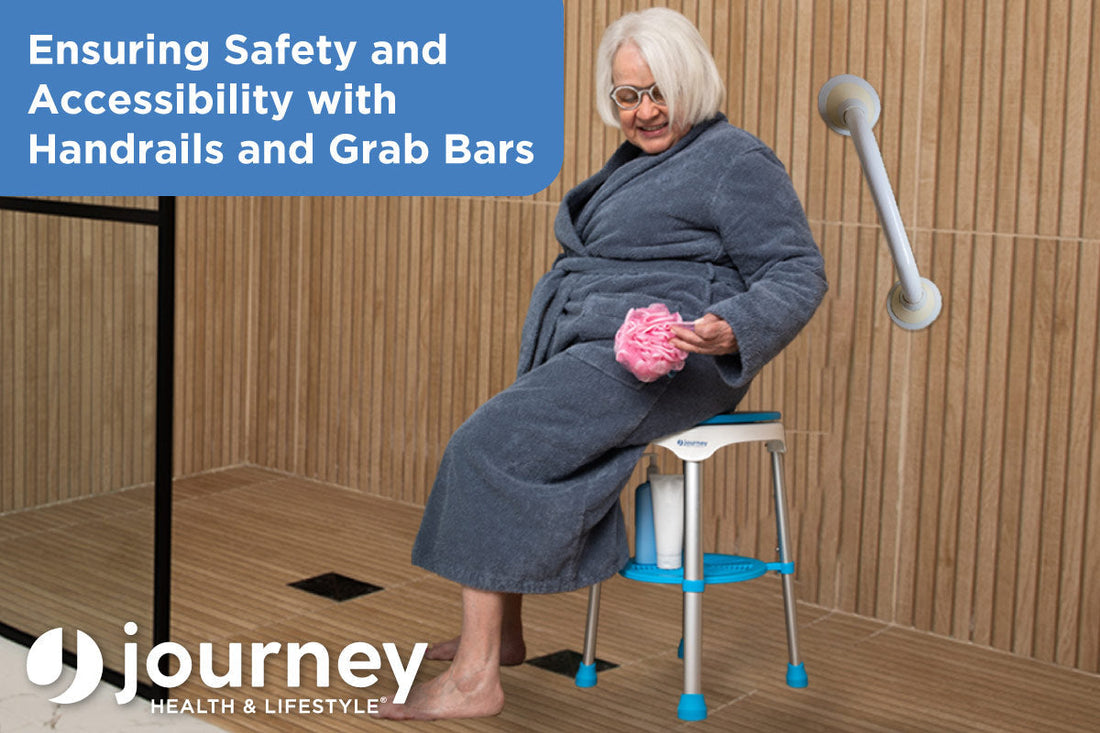M-F 9:30am - 7pm EST
Ensuring Safety and Accessibility: Handrails and Grab Bars

Handrails and grab bars are essential features in any home or public space designed to promote safety and accessibility. Whether to assist individuals with mobility challenges, prevent accidents, or comply with building codes, these support systems are crucial for creating secure environments.
Understanding the types, placement, and installation of these devices can significantly enhance their effectiveness and usability. By adhering to building codes and standards, such as the Americans with Disabilities Act (ADA), these devices ensure accessibility and safety for all users.
Types of Support Bars

Handrails
Handrails are designed for use along stairways and ramps, offering continuous support for individuals navigating changes in elevation. They are typically installed at a height of 34 to 38 inches above the walking surface.
Grab Bars
Grab bars provide support in areas like bathrooms, where slippery surfaces increase the risk of falls. They are often installed near toilets, in showers, and around tubs to assist with balance and transfers.
Safety Poles
Safety poles are vertical support structures that can be placed in various areas, such as bedrooms and living spaces, to assist with standing or transitioning between sitting and standing positions.
Choosing the Right Support Bars
When selecting a bar, consider several key factors. The diameter should be between 1.25 and 2 inches for comfortable gripping. Ensure the bar has a weight capacity of at least 250 pounds to safely accommodate most users. Additionally, choose a finish that complements the surrounding decor and provides a non-slip surface for added safety and aesthetic appeal.
Support Bar Material Options
- Metal: Durable and often corrosion-resistant, metal bars are ideal for wet environments like bathrooms.
- Wood: Offers a natural and aesthetic look but requires proper sealing to prevent moisture damage.
- Plastic: Lightweight and versatile, suitable for various applications but may have lower weight capacities.
Prioritize Proper Placement
Installing handrails and grab bars is a great way to adapt a space to improve accessibility. Grab bars can offer extra support in long corridors, while support bars can be installed near kitchen workspaces for added stability. Install safety poles or grab bars near the bed or chair to assist with standing.
Install handrails on both sides of stairs and ramps for maximum support. Handrails should be continuous along the entire length of the flight at a height of 34-38 inches above the walking surface.
Since a whopping 80% of falls in the home happen in the bathroom, there are additional safety concerns to address. Bathrooms tend to be smaller environments that get wet easily. For example, a splash of water when getting out of the shower can create a slippery area that is dangerous to navigate.

Place grab bars in shower and tub areas to assist with entering and exiting. Install bars near toilets for support during transfers. Ensure the bathroom is accessible and easy to navigate. Consider installing a shower chair and/or toilet assist commode to improve bathroom safety while maintaining independence.
Need some help deciding on solutions for individual mobility needs? Consult with an occupational therapist to determine what kinds of support bars to install. Consider futureproofing by anticipating potential changes in support requirements.
Safety Modification Installation Guidelines
Make sure any devices such as handrails and grab bars are securely mounted. Before installation, locate studs in the wall using a stud finder to identify secure mounting points. Follow manufacturer instructions and use appropriate anchors and installation techniques for the wall material, as instructions vary between drywall, tile, concrete, and other materials.
Secure grab bars to wall studs for maximum stability. If studs are not available, use heavy-duty anchors. Select screws that match the bar’s material and application. Ensure a minimum clearance of 1.5 inches between the bar and the wall to allow a firm grip. Avoid fittings that allow rotation, which can compromise the stability of the grab bar. Use rounded edges to minimize the risk of injury.
Regularly check to make sure that grab bars, handrails, and safety poles are stable and securely mounted. Replace or upgrade if they show signs of wear, damage, or instability. Clean them regularly with appropriate materials to prevent corrosion and maintain hygiene.
Create a Safer Environment
Handrails and grab bars play a vital role in ensuring safety and accessibility in homes and public spaces. By choosing the right materials, placing them effectively, and adhering to proper installation guidelines, you can create a secure environment for all users. For complex installations, seek professional assistance to ensure compliance with safety standards and optimal performance.






